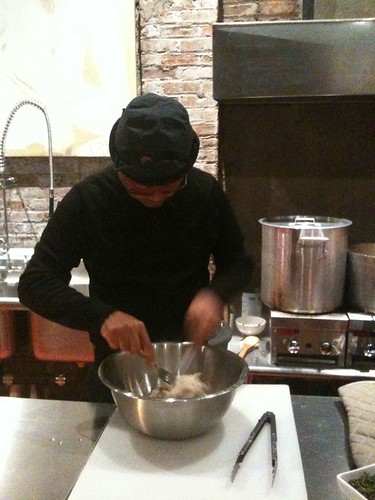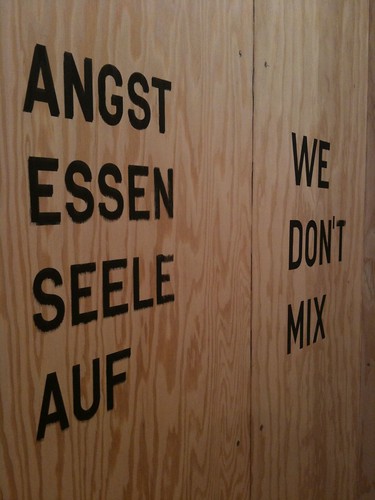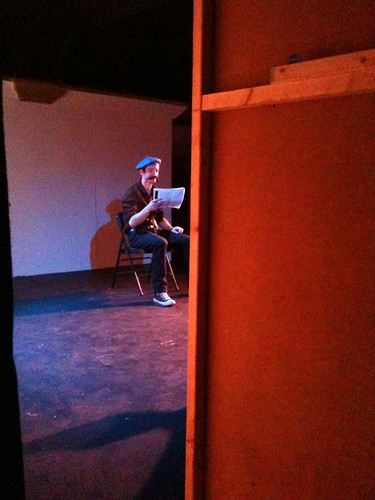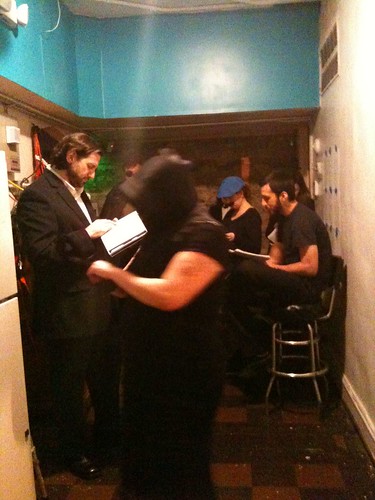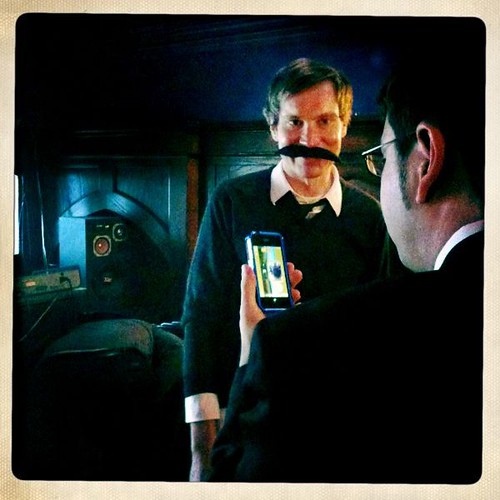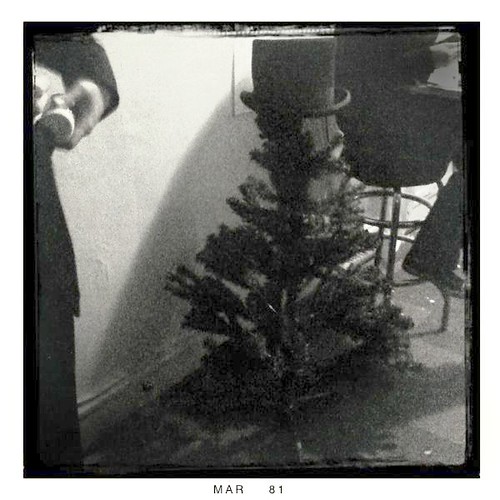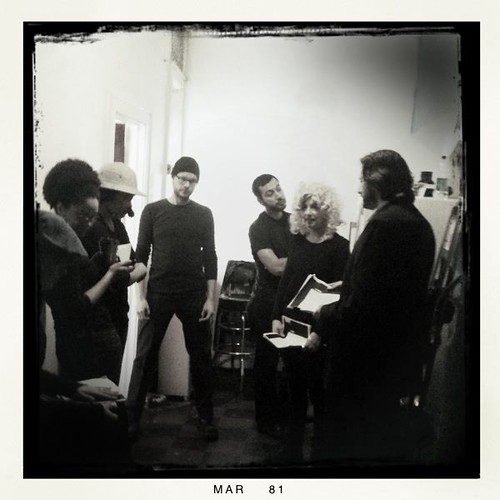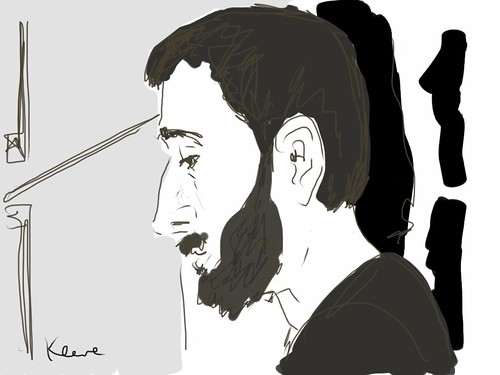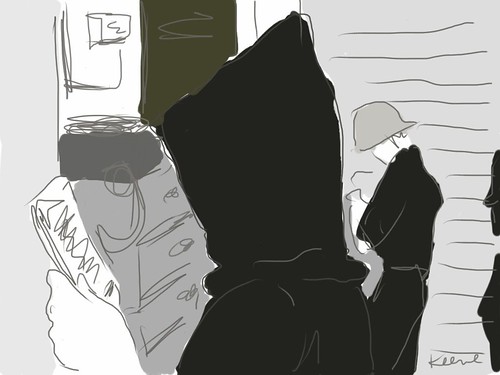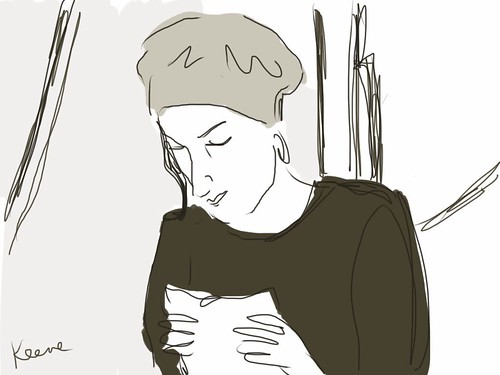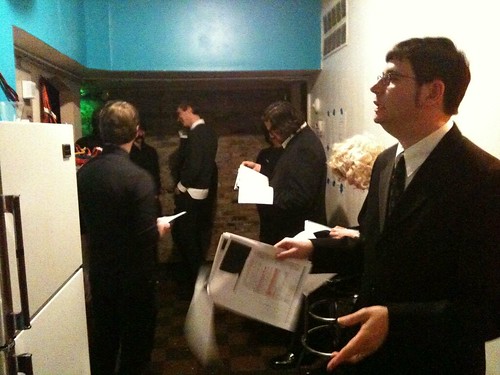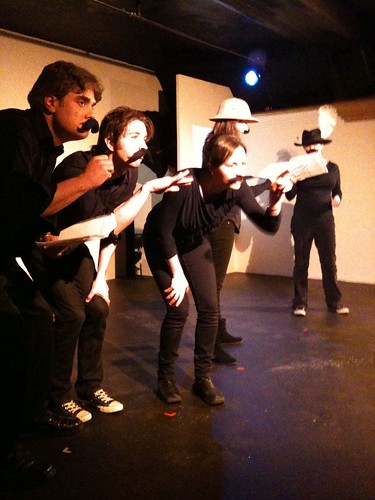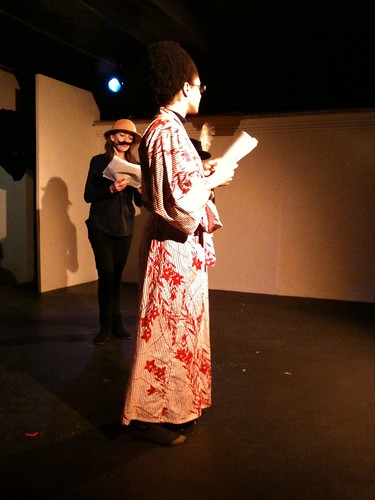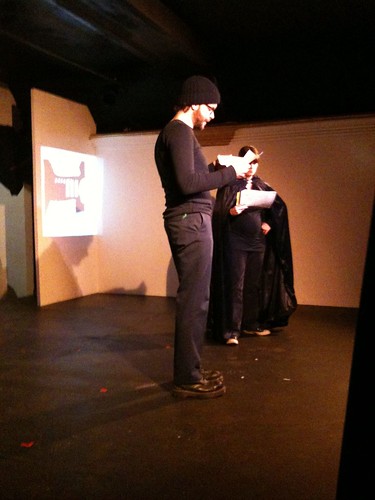 |
Mirror, (2002), Coal
dust, print ink,
glue, gesso,
and graphite
on canvas
82 5/8x55 1/8 in.
Collection of Mellody
© Glenn Ligon |
Last Friday, I traipsed over to the Whitney Museum to view
Glenn Ligon: America, the first mid-career retrospective of Ligon (1960-), an artist who is perhaps best known for his wall-sized, oil and coal dust text paintings from the 1990s through today. (I must note immediately that his beautiful painting "Black Like Me #3 (Study)," from 1992, graces my first book,
Annotations.) The Whitney rightly devotes a floor to Ligon's oeuvre, which consists not only of the paintings but of drawings, prints, photography, and multimedia installations, including sculptures, which together suggest a coherent approach, across forms, that define the possibilities, and perhaps strike the limits, of what identitarian art might do. I use the term "identitarian" with advisement, since I think that Ligon's work exceeds being so easily categorized, but seeing this art, all of it of considerable technical mastery and distinction, a good deal of it even more beautiful when viewed up close (especially the oil text paintings!), brought me back to the core of what the earliest of these works suggest: Ligon's investigations into questions of identity, racial, sexual, social, political, cultural--his own and those of people around him, in America and outside our shores.
What the works also evoked for me, almost in the sense of setting forth a world, of calling into existence the moment of their creation and first appearance, the fraught period of the 1980s and 1990s, when identity-based art surged to the forefront of public consciousness and discussion, just as other genres, such neo-Expressionism and the second waves of minimalism, conceptual and performance art were waning, and I could feel myself reliving some of the debates I witnessed, that I participated in; I could feel the polemics in favor of (which I passionately was and still am) and against this work, which was and, I would argue continues to be important, especially given how crucial it is in reminding of the broader political, economic and social turmoils of that period. The era of the
Reagan, Bush I and early
Clinton presidencies has been reduced to a caricature these days (Saint Reagan! The greatest president ever! blah blah blah; George H. W. Bush has virtually disappeared; the relentless attacks against Clinton and his centrist policies, even before he was elected, now almost completely forgotten in the public discourse even as they mirror what
Michael Dukakis, and later
Al Gore,
John Kerry, and
Barack Obama have endured), but the brutality and ugliness of that period, the period of the
AIDS pandemic's emergence, of the
anti-affirmative action and
anti-abortion fanaticism, of
white racial retrenchment and the
rise of the militia movement, of the
anti-Japanese and
anti-immigrant testeria, of
supply-side economic's intellectual triumph and practical failure, of the lust for
warmongering and the buildup of the
military-industrial and
security states, of the
ramped-up deindustrialization of the country, of the
rise of the crack epidemic, of the
cultural wars in and outside the academy, etc., all of these forming the foundations for our current moment and yet phantasmal in our mass media, also all form the backdrops to Ligon's art.
 |
Untitled (I Am a
Man (1960)
Oil and enamel
on canvas,
40x25 in.
Collection of
the artist.
© Glenn Ligon |
Walking through each room, I felt something akin to the beating wings of Benjamin's
angelus novus, but a black, queer, cosmopolitan, left-leaning, and indefatigable one, against my cheek: the now-time (
Jetztzeit) of that earlier era, the era of my 20s, the period of
Slackers, of
Public Enemy, of
Eleanor Bumpers and
Tawana Brawley, of
Do the Right Thing, of
ACT-UP and
Queer Nation, of the last glimmers of
Gay Liberation, of
Essex Hemphill and
Marlon Riggs, of
Audre Lorde still alive speaking out against
Jesse Helms, etc., was there with me even as I was firmly in our present moment, with its host of grave concerns. What I also began to feel, as I reached Ligon's pieces invoking the runaway slave posters, was that a great deal of this art was perhaps, in some ways, too much of its time; universal yes, and yet perhaps too anchored in that earlier moment whose issues are still with us, but in different ways. The retrospective, to put it another way, felt insistently
historical, indexing not only Ligon's history, but the country's, the society's, my own. It felt--dated perhaps is too strong a word, but while the formal power of the work struck me as transcendant, especially the oil text pieces, a good deal of the other aspects of the work felt as if it reflected a moment that had passed, but also, as if it were in some ways trapped, as if in amber, in that moment. In a sense, this underpins some of the past criticism of this work, and of similar art of this or earlier periods, which I must admit upsets me, in part because I worry that in viewing the art in this life I may be undercutting Ligon's achievement, that I am falling into the trap of arguing that art probing identity, particularly the identifications and intersectionalities so central to Ligon's work, cannot transcend its moment, cannot resonate beyond the particular contexts in which it was created; but another way of looking at it might be to say that some of Ligon's work does and will continue to do this, but some of it does and will not. Perhaps, as an artist I greatly respect suggested to me a few weeks later when we discussed the exhibit, what might benefit some of these pieces down the road would be for them to be exhibited with other works of this era, thus providing an even richer immersion in a conversation whose urgency we forget at our peril.
 |
Notes on the Margins
of the Black Book
(1991-93), (detail)
91 offset prints
11 1/2x11 1/2 in.
(framed) 78 text
pages, 5 1/4x7 1/4
each (framed)
Solomon R. Guggenheim
Museum;
gift of the
Bohen Foundation
© Glenn Ligon |
I do want to call attention to one part of the exhibit that particularly took me back to the late 1980s and early 1990s, and somewhat shook me up. That was Ligon's
Notes on the Margins of the Black Book (1991-1993), his response to
Robert Mapplethorpe's highly controversial 1988 volume
The Black Book, which preceded Mapplethorpe's even more charged 1989 exhibit
Robert Mapplethorpe: The Perfect Moment. Ligon's exhibit essayed and assayed the responses, from a range of viewers, some famous scholars and critics like
Stuart Hall to figures depicted in the portraits themselves to Mapplethorpe himself, figuratively and physically breaking down the book, image by image, page by page, to critique and open up ways of seeing, reading, understanding, and interpreting--which is to say, experiencing--Mapplethorpe's, and by extension, this society's, views of black men, the black male body, the black body, blackness itself. Ligon's interpretive practice here was and remains quite remarkable; it suggested in its richness some of the subsequent revisionings of Mapplethorpe's work by
Kobena Mercer and others, while also demonstrating another powerful, effective and moving method of critique. (It would do us all a bit of good never to forget that art, and not just academic criticism, has this capacity, and when it does so effectively it can reach a great deal more people.) I recalled my own reading of
The Black Book, my own youthful critiques and conflicts, at the power being accorded Mapplethorpe, at what I read as objectification, at my own insistent attraction to the images, at my desire for someone black, someone of color, to attempt something of this sort and the frustration I knew I would feel as it went ignored by the wider culture in ways that Mapplethorpe's art never would, and so on. Ligon in fact captures all these feelings and many more--some were
his own, reflected in the range of commentary, the juxtapositions of image and text, the sheer panorama of visuality that both magnetized--and magnetizes still--as it overwhelms. This was one aspect of the exhibit that reminded me of why Ligon is such an important artist, and why I hope he continues to make art, especially work that engages the themes and tropes of our times.
One thing I found surprising was that the exhibit did not include--or perhaps I missed them!--Ligon's playful photographic and digital projects from the mid-to-late 1990s, such as
Feast of Scraps (1994-98), in which he juxtaposed family photographs with vintage gay pornography, many of the images featuring black men. One outgrowth or extension of this work appeared in his online
Dia Center for the Arts project "
Annotations" (no reference whatsoever to my book), which is available
here (click on "Annotations"). This work struck me as opening out into really interesting possibilities in terms of the emerging queer studies and discourses on and around family, geneologies, filiations and affiliations, and so on, and its use of digital media also marked what I took to be new directions on Ligon's work. But as I said, I did not see this in the Whitney show, and perhaps missed it. If not, I hope that in a future show and in his work to come Ligon resumes it, especially because it was in conversation with some of the exciting work that
Thomas Allen Harris has been undertaking around black families and geneologies but also prefigured the mainstream gay shift towards discussions of marriage, family, homonormativities (which Ligon was queering in very interesting ways), and LGBT relationships in the late 20th and early 21st centuries. All in all, I highly recommend seeing the exhibit, and look forward to seeing another retrospective of his work several decades down the road.


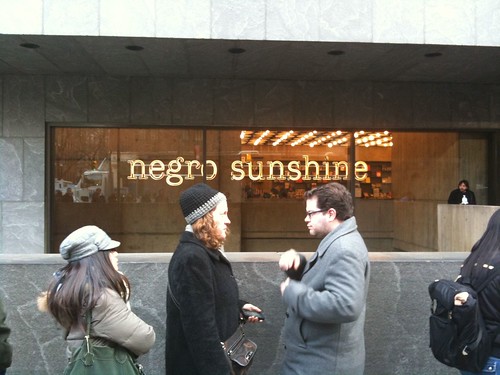



![The days of this society is [sic] numbered](http://farm6.static.flickr.com/5011/5561592845_242021db09.jpg)
